

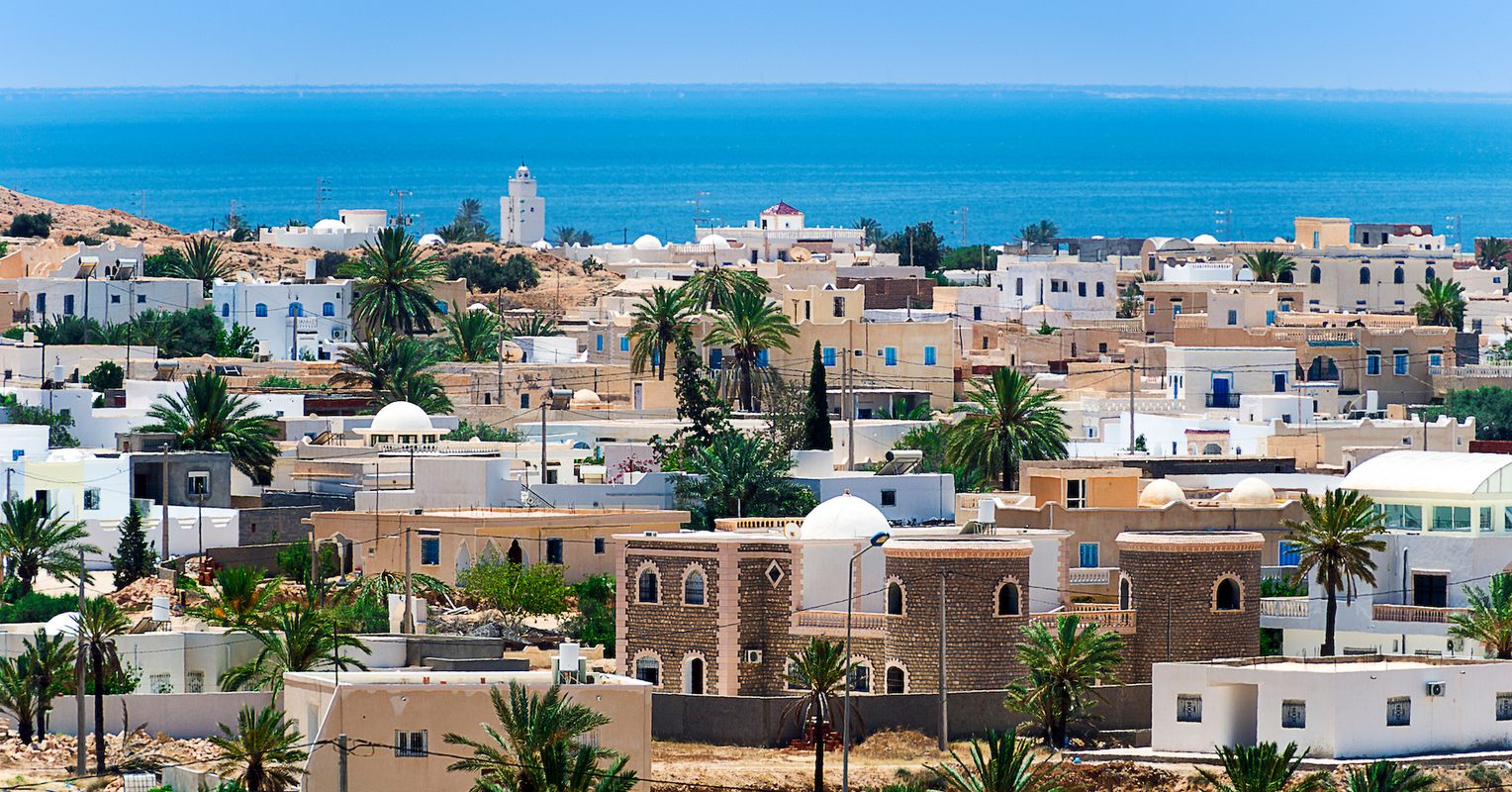
Africa
13 days
12 nights
12 people
Moderate
History & Culture

Join us in Tunis, the capital of Tunisia and once the heart of Africa’s Roman Empire, as we journey into the Sahara desert and back. We'll loop through a myriad of unique landscapes, wander through winding medinas, relax by ancient oases, and cross a multicolored salt lake. Along the way, we'll explore relics of the many civilizations that once called this land home—from the ruins of Carthage to the remains of Roman amphitheaters. Bounded by endless desert sands and crisp Mediterranean waters, Tunisia’s architecture, culture, and cuisine are as diverse and dynamic as its millennia-old history.
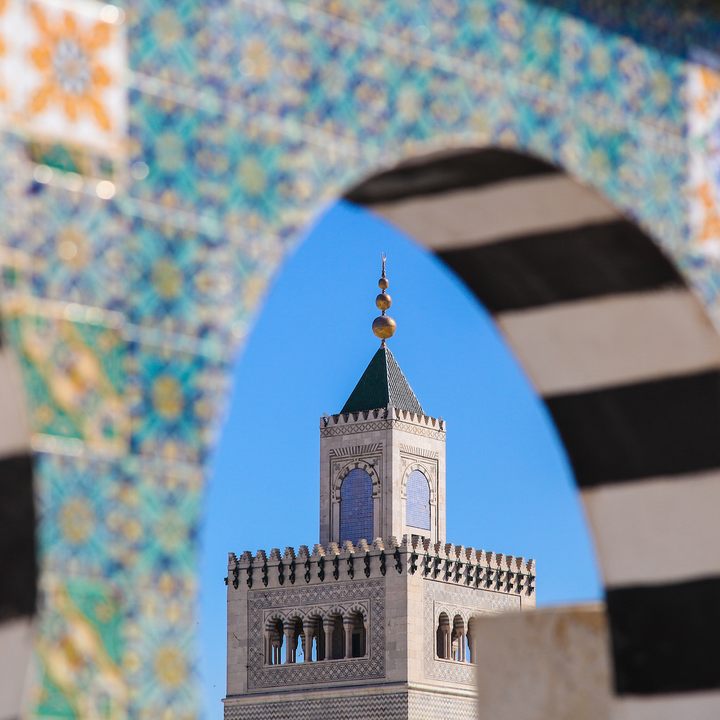
Arrive into Tunis-Carthage International Airport and head over to our historical hotel nestled in the heart of the nation’s capital. You’ll ease into the day with a guided walking tour, exploring the city’s sunny squares, maze-like alleyways, and well-preserved historical district. You’ll weave through the Tunis Medina, a city-within-a-city home to thousands of market stalls, restaurants, and mosques, and get the lowdown on what makes Tunis tick, pausing to sample some snacks—perhaps a steaming deep-fried, yolk-filled brik à l'oeuf. However, you’ll want to save some room since we’ll be stopping by one of the best restaurants in Tunis for our welcome dinner this evening!

Arrive into Tunis-Carthage International Airport and head over to our historical hotel nestled in the heart of the nation’s capital. You’ll ease into the day with a guided walking tour, exploring the city’s sunny squares, maze-like alleyways, and well-preserved historical district. You’ll weave through the Tunis Medina, a city-within-a-city home to thousands of market stalls, restaurants, and mosques, and get the lowdown on what makes Tunis tick, pausing to sample some snacks—perhaps a steaming deep-fried, yolk-filled brik à l'oeuf. However, you’ll want to save some room since we’ll be stopping by one of the best restaurants in Tunis for our welcome dinner this evening!
Hotel Carlton or similar, Tunis
Welcome Dinner
Hotel Carlton or similar, Tunis
Welcome Dinner
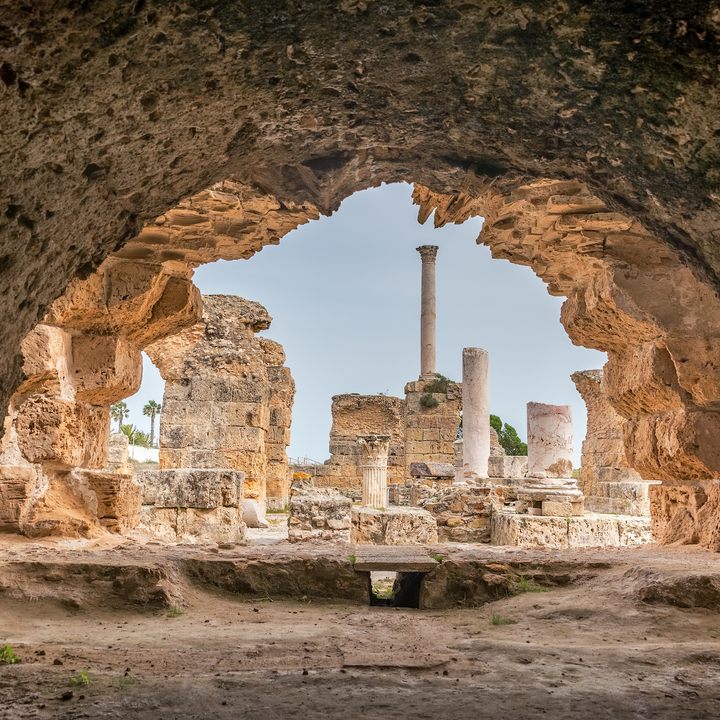
This morning, you’ll hurtle back in time a few thousand years as we explore the relics of Carthage, once the most powerful trading city in the Western Mediterranean. Dating back to the ninth century BCE, it was the birthplace of the formidable warlord Hannibal, who allegedly marched his massive army complete with war elephants through the Alps to invade Rome. You’ll trace the history of the ancient city from the enormous Roman-era cisterns of La Malga to enigmatic Carthaginian sites of sacrifice. In the afternoon, head to a favorite local spot: the beachside town of La Goulette, where you’ll slurp down fresh fish and grilled seafood, and look out over the shimmering Mediterranean. Once we get back to Tunis, take some time to explore the bustling markets and Brutalist architecture of the city before dinner.

This morning, you’ll hurtle back in time a few thousand years as we explore the relics of Carthage, once the most powerful trading city in the Western Mediterranean. Dating back to the ninth century BCE, it was the birthplace of the formidable warlord Hannibal, who allegedly marched his massive army complete with war elephants through the Alps to invade Rome. You’ll trace the history of the ancient city from the enormous Roman-era cisterns of La Malga to enigmatic Carthaginian sites of sacrifice. In the afternoon, head to a favorite local spot: the beachside town of La Goulette, where you’ll slurp down fresh fish and grilled seafood, and look out over the shimmering Mediterranean. Once we get back to Tunis, take some time to explore the bustling markets and Brutalist architecture of the city before dinner.
Hotel Carlton or similar, Tunis
Breakfast, Lunch, Dinner
Hotel Carlton or similar, Tunis
Breakfast, Lunch, Dinner

After an early breakfast, you’ll hit the road and make our first stop in Sousse, a busy port city that lies on the Gulf of Hammamet. Visit the Sousse Archaeological Museum located within the walls of a historic kasbah with panoramic views over the city. The museum houses one of the world's greatest collections of Roman mosaics. You will have time for self-exploration of the museum in addition to learning more about the mosaics from your guide. You’ll wander through Sousse's narrow, millennia-old streets before taking a break for lunch. This afternoon continues on to Kairouan, one of the holy cities of Islam and an important pilgrimage site. You’ll spend some time exploring Kairouan's fantastic medina on a guided walk and meeting the craftspeople at work before having a relaxing evening at your hotel.

After an early breakfast, you’ll hit the road and make our first stop in Sousse, a busy port city that lies on the Gulf of Hammamet. Visit the Sousse Archaeological Museum located within the walls of a historic kasbah with panoramic views over the city. The museum houses one of the world's greatest collections of Roman mosaics. You will have time for self-exploration of the museum in addition to learning more about the mosaics from your guide. You’ll wander through Sousse's narrow, millennia-old streets before taking a break for lunch. This afternoon continues on to Kairouan, one of the holy cities of Islam and an important pilgrimage site. You’ll spend some time exploring Kairouan's fantastic medina on a guided walk and meeting the craftspeople at work before having a relaxing evening at your hotel.
Hôtel La Kasbah or similar, Kairouan
Breakfast, Lunch, Dinner
Hôtel La Kasbah or similar, Kairouan
Breakfast, Lunch, Dinner
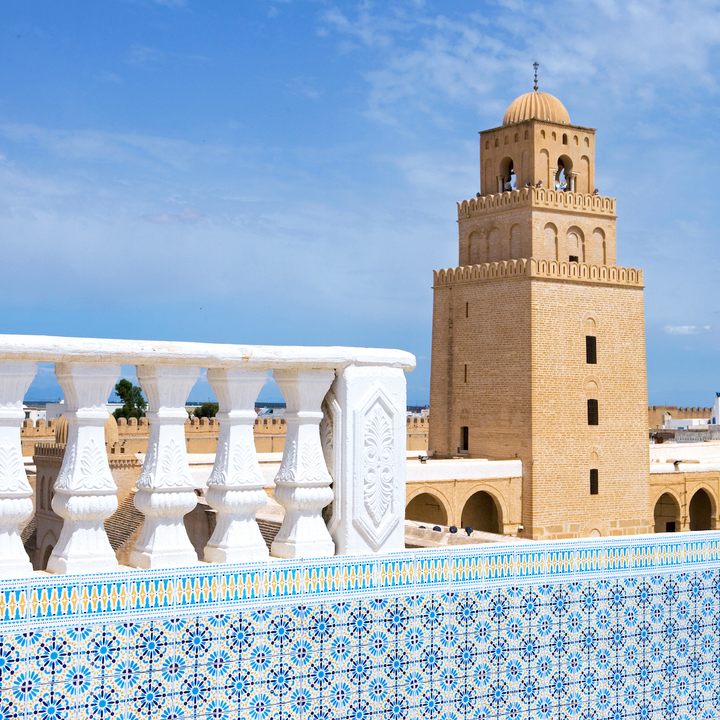
Today you’ll visit the Grand Mosque, a spectacular structure complete with an elaborate mihrab and intricately carved columns, and search for what’s believed to be the oldest surviving minbar (pulpit) in the world. You’ll continue on to the Aghlabid Basins, giant hydraulic structures erected in the ninth century that provided water for the people of Kairouan for over a millennium. Later, you’ll visit a few lesser-known spots, such as the alleged burial site of Muhammad’s barber. After lunch, the remainder of the afternoon is free for further exploration of the alleys and hidden gems of the Kairouan Medina or relaxation at the hotel.

Today you’ll visit the Grand Mosque, a spectacular structure complete with an elaborate mihrab and intricately carved columns, and search for what’s believed to be the oldest surviving minbar (pulpit) in the world. You’ll continue on to the Aghlabid Basins, giant hydraulic structures erected in the ninth century that provided water for the people of Kairouan for over a millennium. Later, you’ll visit a few lesser-known spots, such as the alleged burial site of Muhammad’s barber. After lunch, the remainder of the afternoon is free for further exploration of the alleys and hidden gems of the Kairouan Medina or relaxation at the hotel.
Hôtel La Kasbah or similar, Kairouan
Breakfast, Lunch, Dinner
Hôtel La Kasbah or similar, Kairouan
Breakfast, Lunch, Dinner
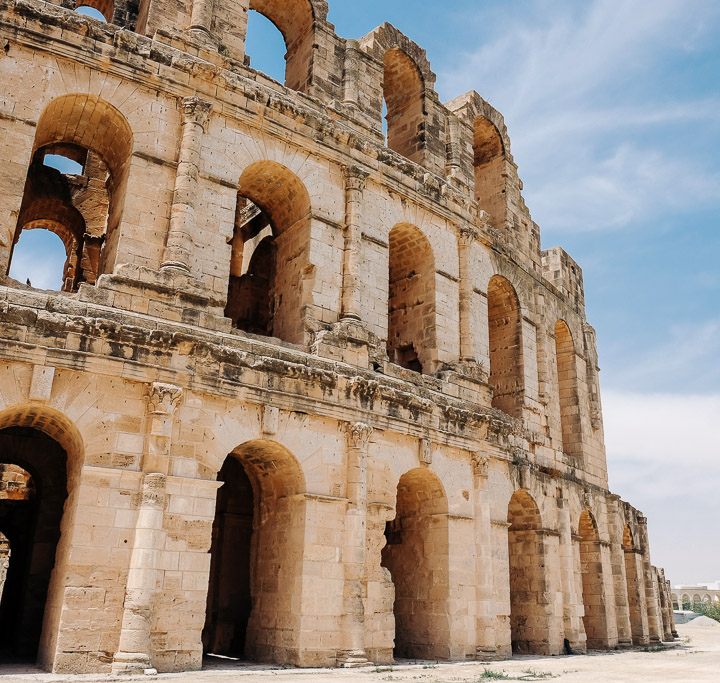
This morning we’ll drive to El Jem, a massive, Roman-era colosseum that hosted gladiatorial battles as early as the third century. With an estimated capacity of 35,000, it’s one of the largest Roman amphitheaters in the world. Next, you’ll catch a ferry to Djerba, also known as “the Island of Dreams.” With a rich history and renowned contemporary art scene, the island is home to a vibrant, longstanding Jewish community—and one of the oldest synagogues in Africa—as well as an open-air art museum, where artists from all around the world have painted mythical beasts, Arabic calligraphy graffiti, and more onto city walls and rooftops.

This morning we’ll drive to El Jem, a massive, Roman-era colosseum that hosted gladiatorial battles as early as the third century. With an estimated capacity of 35,000, it’s one of the largest Roman amphitheaters in the world. Next, you’ll catch a ferry to Djerba, also known as “the Island of Dreams.” With a rich history and renowned contemporary art scene, the island is home to a vibrant, longstanding Jewish community—and one of the oldest synagogues in Africa—as well as an open-air art museum, where artists from all around the world have painted mythical beasts, Arabic calligraphy graffiti, and more onto city walls and rooftops.
Hôtel Dar Dhiafa or similar, Djerba
Breakfast, Lunch, Dinner
Hôtel Dar Dhiafa or similar, Djerba
Breakfast, Lunch, Dinner
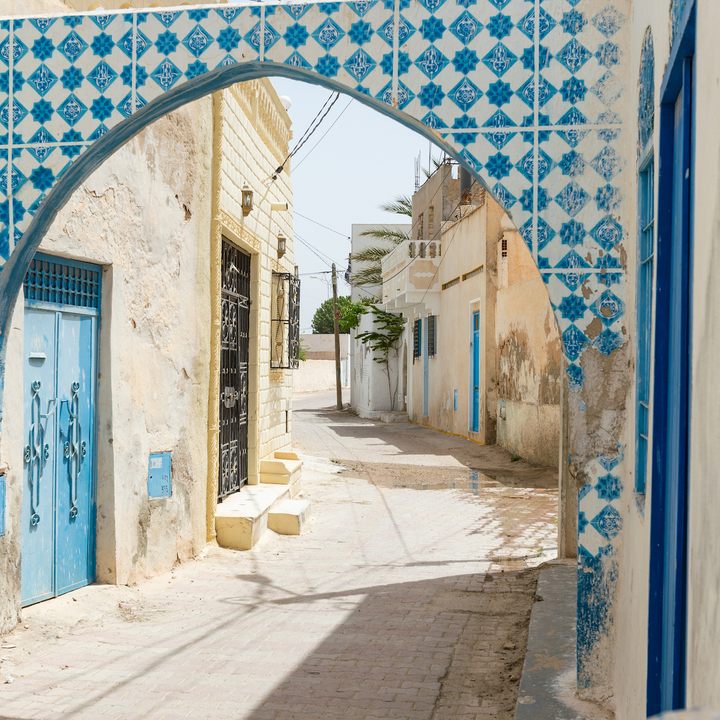
Spend the morning exploring Djerba, visiting the El Ghriba Synagogue before delving into the medina on foot and seeing the larger-than-life Djerbahood murals splashed across city walls. For lunch, you’ll head to the medina, where fishermen display their catch. After selecting what we need, we’ll ask a local restaurant to grill up our fish. Next you’ll explore an abandoned beach resort and learn about the Jasmine Revolution, a 2011 civil protest against decades of corruption that sparked the Arab Spring. Then it’s time for your journey into the Sahara. You’ll cross the first of the desert’s massive salt lakes before arriving at our destination, a stone house at the base of mountains in Tataouine. After a long day full of adventure, we’ll fire up the grill for a BBQ by the pool before calling it a night.

Spend the morning exploring Djerba, visiting the El Ghriba Synagogue before delving into the medina on foot and seeing the larger-than-life Djerbahood murals splashed across city walls. For lunch, you’ll head to the medina, where fishermen display their catch. After selecting what we need, we’ll ask a local restaurant to grill up our fish. Next you’ll explore an abandoned beach resort and learn about the Jasmine Revolution, a 2011 civil protest against decades of corruption that sparked the Arab Spring. Then it’s time for your journey into the Sahara. You’ll cross the first of the desert’s massive salt lakes before arriving at our destination, a stone house at the base of mountains in Tataouine. After a long day full of adventure, we’ll fire up the grill for a BBQ by the pool before calling it a night.
Ksar Ouled Debbab Hotel, Al Rayan or similar, Tataouine
Breakfast, Lunch, Dinner
Ksar Ouled Debbab Hotel, Al Rayan or similar, Tataouine
Breakfast, Lunch, Dinner
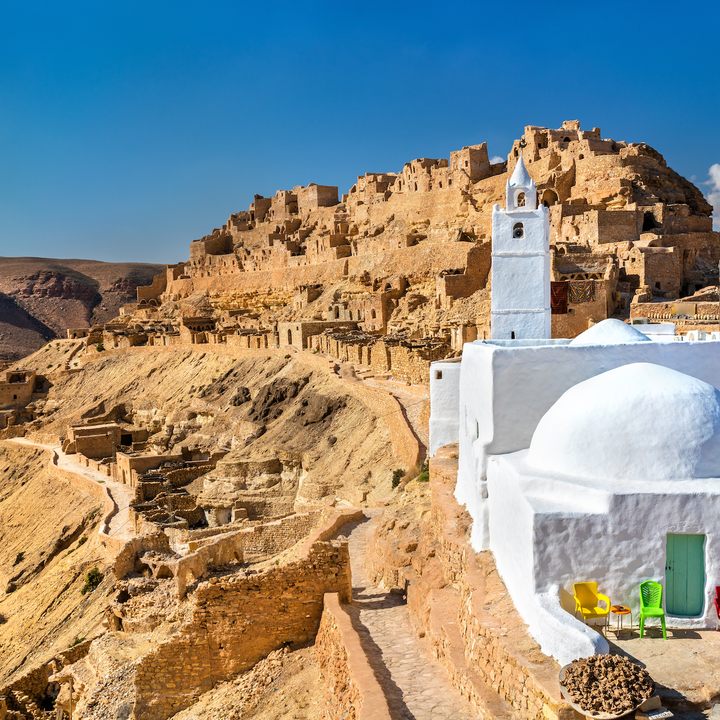
Today you’ll be exploring Tataouine from various vantage points, from its hilltop caves to its underground dugouts—and even taking an intergalactic perspective. Made famous by its Star Wars namesake, Tatooine, the town still hosts a smattering of otherworldly relics from the film set. Whether you’re a Star Wars fan or not, you’ll likely conclude this area to be one of the most visually stunning places you’ve ever seen. You’ll share a traditional Berber meal with a few new friends, and drop into a cave for a cup of tea. Then, you’ll head to Chenini, an ancient Berber village tucked into the cliffs, which served as inspiration for the name of a moon orbiting Luke Skywalker’s home planet. After a full day of exploring, you’ll return to your hotel to rest up before tomorrow’s adventure into the desert.

Today you’ll be exploring Tataouine from various vantage points, from its hilltop caves to its underground dugouts—and even taking an intergalactic perspective. Made famous by its Star Wars namesake, Tatooine, the town still hosts a smattering of otherworldly relics from the film set. Whether you’re a Star Wars fan or not, you’ll likely conclude this area to be one of the most visually stunning places you’ve ever seen. You’ll share a traditional Berber meal with a few new friends, and drop into a cave for a cup of tea. Then, you’ll head to Chenini, an ancient Berber village tucked into the cliffs, which served as inspiration for the name of a moon orbiting Luke Skywalker’s home planet. After a full day of exploring, you’ll return to your hotel to rest up before tomorrow’s adventure into the desert.
Ksar Ouled Debbab Hotel, Al Rayan or similar, Tataouine
Breakfast, Lunch, Dinner
Ksar Ouled Debbab Hotel, Al Rayan or similar, Tataouine
Breakfast, Lunch, Dinner
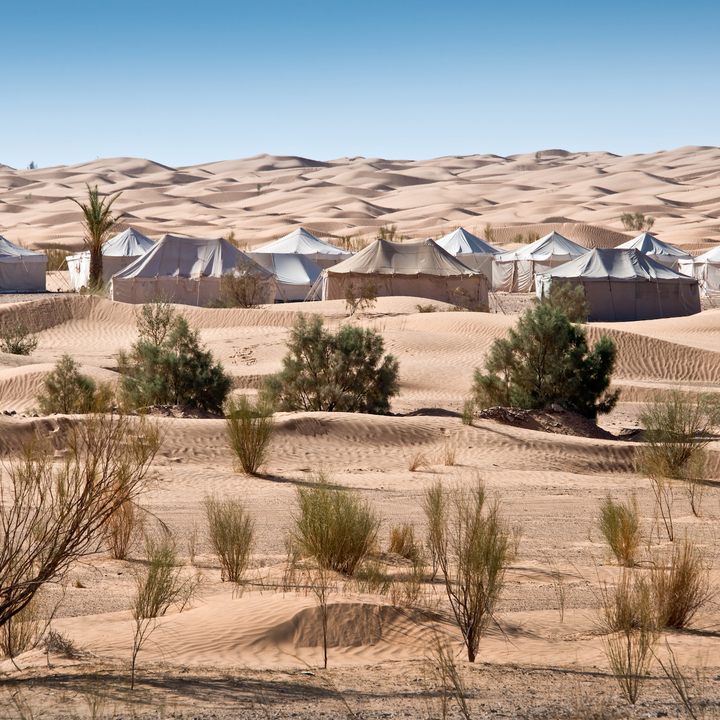
You’ll set out early this morning, driving up into the mountains, where we’ll stop for a coffee break with panoramic views. You’ll pass innumerable natural wonders, including a hot-water desert spring, often thronged by thirsty camels. Once we reach the desert, we’ll switch over to all-terrain vehicles and journey 60 miles from the nearest human settlement until we reach our campsite. We’ll set up camp, enjoy a traditional Berber dinner by the campfire, and, once the sun sets, turn our gaze to the sky. With the closest source of electricity about a two-hour drive from our camp, we’ll enjoy the glittering mosaic of stars and planets in the night sky with unparalleled lucidity. Tonight we’ll have comfortable tents to sleep in, though you’re also welcome to bring a blanket outside and drift off underneath the stars.

You’ll set out early this morning, driving up into the mountains, where we’ll stop for a coffee break with panoramic views. You’ll pass innumerable natural wonders, including a hot-water desert spring, often thronged by thirsty camels. Once we reach the desert, we’ll switch over to all-terrain vehicles and journey 60 miles from the nearest human settlement until we reach our campsite. We’ll set up camp, enjoy a traditional Berber dinner by the campfire, and, once the sun sets, turn our gaze to the sky. With the closest source of electricity about a two-hour drive from our camp, we’ll enjoy the glittering mosaic of stars and planets in the night sky with unparalleled lucidity. Tonight we’ll have comfortable tents to sleep in, though you’re also welcome to bring a blanket outside and drift off underneath the stars.
Desert tents, Campement Zmela Labrissa
Breakfast, Lunch, Dinner
Desert tents, Campement Zmela Labrissa
Breakfast, Lunch, Dinner

After breakfast in the desert, you'll cross the vast, multicolored Chott el Djerid salt lake. Appearing in shades of green, red, and white, the (mostly dry) lake will give you lots to look at as we drive through it. We’ll pause in the middle, getting out to examine its brilliant pink hue before continuing on to Douz. Stop here, just a stone’s throw from the Algerian border, to break for lunch and stretch your legs. Later, you’ll visit Les Refroidisseurs d’Eau, a gargantuan, concrete facility built to process, cool, and store the hot water that bubbles up from beneath the desert sand. A hidden gem not often frequented by outsiders, it’s the perfect place to enjoy a free, hot, mineral water shower. Your final destination for the day will be Tozeur, a tropical oasis deep in the desert, where you’ll taste the city’s world-renowned lamb before retiring to your hotel.

After breakfast in the desert, you'll cross the vast, multicolored Chott el Djerid salt lake. Appearing in shades of green, red, and white, the (mostly dry) lake will give you lots to look at as we drive through it. We’ll pause in the middle, getting out to examine its brilliant pink hue before continuing on to Douz. Stop here, just a stone’s throw from the Algerian border, to break for lunch and stretch your legs. Later, you’ll visit Les Refroidisseurs d’Eau, a gargantuan, concrete facility built to process, cool, and store the hot water that bubbles up from beneath the desert sand. A hidden gem not often frequented by outsiders, it’s the perfect place to enjoy a free, hot, mineral water shower. Your final destination for the day will be Tozeur, a tropical oasis deep in the desert, where you’ll taste the city’s world-renowned lamb before retiring to your hotel.
Dar Tozeur, Dar Nejma or similar, Tozeur
Breakfast, Lunch, Dinner
Dar Tozeur, Dar Nejma or similar, Tozeur
Breakfast, Lunch, Dinner
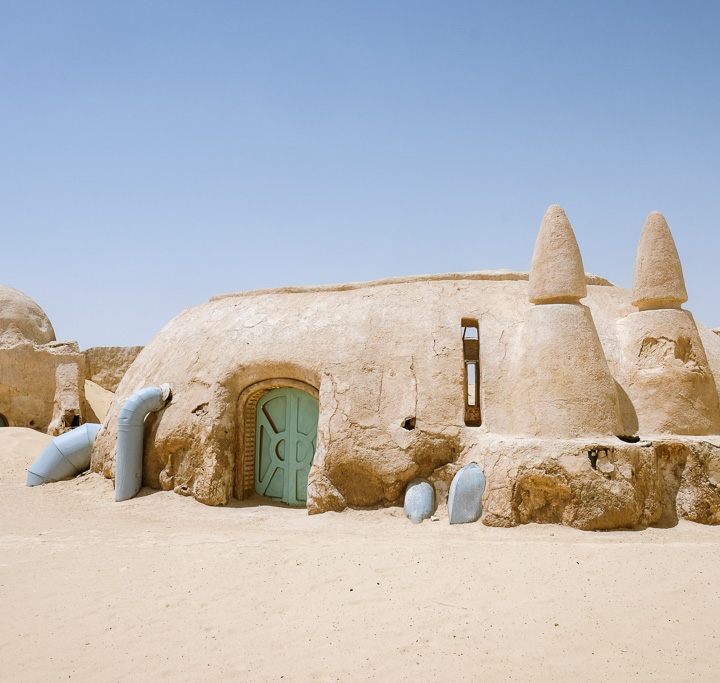
Start the day off-roading and, with the help of your trusty (four-wheel-drive) steeds, you’ll cruise back across the Saharan sands, passing oases and bountiful date farms as you go. Your first stop is a beautiful canyon that is only accessible on foot via an easy hike. Back in the vehicles and continuing on your way, we’ll stop at another abandoned Star Wars film set, the town of Mos Espa. Though the set is slowly being overtaken by sand, you can still spot “Moisture Vaporators,” among other space structures, lining the streets. Break for lunch in Tozeur, and check out the local medina and souk. For those interested, there’s an optional excursion to yet another Star Wars relic—the Lars Homestead, home to Luke Skywalker, himself!

Start the day off-roading and, with the help of your trusty (four-wheel-drive) steeds, you’ll cruise back across the Saharan sands, passing oases and bountiful date farms as you go. Your first stop is a beautiful canyon that is only accessible on foot via an easy hike. Back in the vehicles and continuing on your way, we’ll stop at another abandoned Star Wars film set, the town of Mos Espa. Though the set is slowly being overtaken by sand, you can still spot “Moisture Vaporators,” among other space structures, lining the streets. Break for lunch in Tozeur, and check out the local medina and souk. For those interested, there’s an optional excursion to yet another Star Wars relic—the Lars Homestead, home to Luke Skywalker, himself!
Dar Tozeur, Dar Nejma or similar, Tozeur
Breakfast, Lunch
Dar Tozeur, Dar Nejma or similar, Tozeur
Breakfast, Lunch
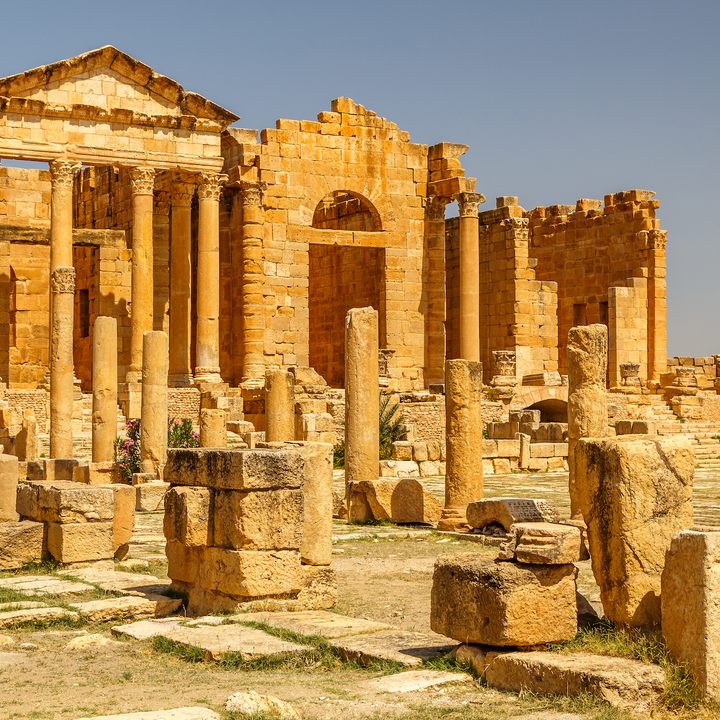
This morning you’ll head north along the Algerian border, from Tozeur to the ancient city of Sbeitla. Also known as “Sufetula,” Sbeitla is believed to have been the point of entry for the Islamic conquest of Africa. You’ll explore local Roman ruins and sample some wild boar, a contemporary delicacy with ancient roots. After a day of walking, exploring, and feasting, enjoy some rest before our final full day together.

This morning you’ll head north along the Algerian border, from Tozeur to the ancient city of Sbeitla. Also known as “Sufetula,” Sbeitla is believed to have been the point of entry for the Islamic conquest of Africa. You’ll explore local Roman ruins and sample some wild boar, a contemporary delicacy with ancient roots. After a day of walking, exploring, and feasting, enjoy some rest before our final full day together.
Hotel Byzacene or similar, Sbeitla
Breakfast, Lunch, Dinner
Hotel Byzacene or similar, Sbeitla
Breakfast, Lunch, Dinner

Dougga is the best-preserved Roman town in North Africa, and arguably anywhere on the planet. An archaeologist’s paradise, its ancient temples, bathhouses, mosaics, and original Roman streets still stand as if frozen in time. We’ll aim to visit its massive theater, chariot racing arena, and the remains of the ancient temple known as the Capitol. Then, you’ll embark upon the final leg of your overland journey, looping back to Tunis. Upon returning to the capital, we’ll celebrate our time together with a farewell dinner.

Dougga is the best-preserved Roman town in North Africa, and arguably anywhere on the planet. An archaeologist’s paradise, its ancient temples, bathhouses, mosaics, and original Roman streets still stand as if frozen in time. We’ll aim to visit its massive theater, chariot racing arena, and the remains of the ancient temple known as the Capitol. Then, you’ll embark upon the final leg of your overland journey, looping back to Tunis. Upon returning to the capital, we’ll celebrate our time together with a farewell dinner.
Hotel Carlton or similar, Tunis
Breakfast, Lunch, Dinner
Hotel Carlton or similar, Tunis
Breakfast, Lunch, Dinner
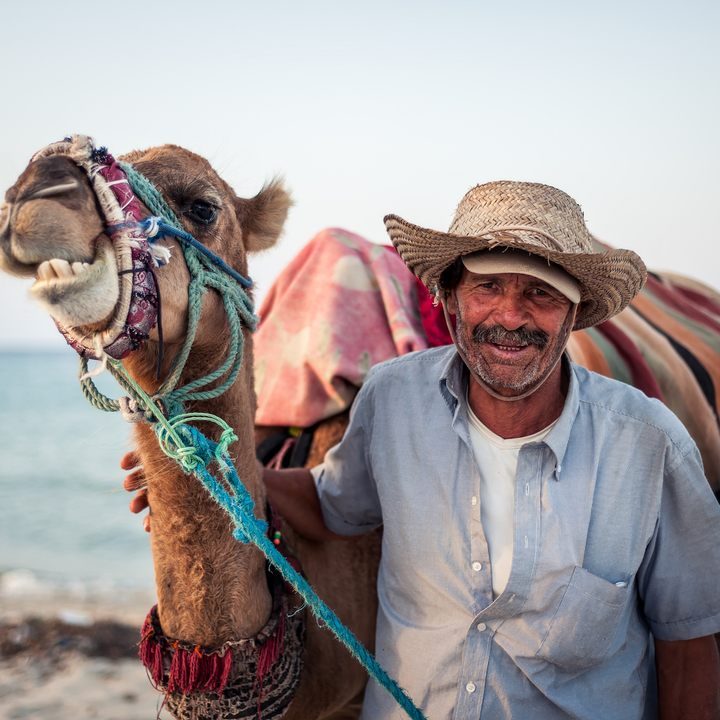
After a final breakfast together, head to the airport and depart for home or your next destination. Until our next adventure!
Breakfast
Deposit to book your trip: $250 USD.
Balance due 90 days prior to departure.
The listed price of the trip is per person based on double occupancy.
Deposit to book your trip: $250 USD.
Balance due 90 days prior to departure.
The listed price of the trip is per person based on double occupancy.
You’re in good company.
Opt for a Private Room to yourself, subject to availability, for a supplemental cost $840 USD.
Solo travelers typically make up about half of our small groups. With curiosity at the center of our experiences, there’s a natural camaraderie that develops over the course of a trip. If you don’t opt for a Private Room, you'll be matched with another solo traveler of the same gender.
You’re in good company.
Opt for a Private Room to yourself, subject to availability, for a supplemental cost $840 USD.
Solo travelers typically make up about half of our small groups. With curiosity at the center of our experiences, there’s a natural camaraderie that develops over the course of a trip. If you don’t opt for a Private Room, you'll be matched with another solo traveler of the same gender.
You should plan to arrive by 12 p.m. on Day 1, and depart anytime on Day 13. Tunis-Carthage International Airport (TUN) connects to a range of flight hubs in Europe and the Middle East. Connecting airlines include Air France, Alitalia, Lufthansa, Emirates, and Qatar Airways.
*Airport transfers are only provided if arriving & departing on the trip dates, or if pre/post arrangements have been made through Atlas Obscura.
You should plan to arrive by 12 p.m. on Day 1, and depart anytime on Day 13. Tunis-Carthage International Airport (TUN) connects to a range of flight hubs in Europe and the Middle East. Connecting airlines include Air France, Alitalia, Lufthansa, Emirates, and Qatar Airways.
*Airport transfers are only provided if arriving & departing on the trip dates, or if pre/post arrangements have been made through Atlas Obscura.
Travelers should feel comfortable walking three to five miles over the course of each day, and remaining on their feet for long periods of time. We’ll be spending a good amount of time outside and in rural areas, walking up and down stairs, and on dirt paths. We’ll also spend a night camping out in the desert.
Travelers should feel comfortable walking three to five miles over the course of each day, and remaining on their feet for long periods of time. We’ll be spending a good amount of time outside and in rural areas, walking up and down stairs, and on dirt paths. We’ll also spend a night camping out in the desert.
For our night out in the desert, we’ll be in nice, pre-set tents with shared facilities that include western toilets and running water (one might even call it “glamping”).
For our night out in the desert, we’ll be in nice, pre-set tents with shared facilities that include western toilets and running water (one might even call it “glamping”).
Check out the Essential Trip Information for this trip or our general FAQs.
Call us at +1 833-919-9154
Send us a
Have a question for us about Tunisia & the Sands of Time? We're here to help!
Call us at +1 646-961-4857
Check out our FAQ
This site is protected by reCAPTCHA and the Google Privacy Policy and Terms of Service apply.
Have a question for us about Tunisia & the Sands of Time? We're here to help!
Call us at +1 833-919-9154
Check out our FAQ
This site is protected by reCAPTCHA and the Google Privacy Policy and Terms of Service apply.
Sign up for our emails.
Have a question for us? We're here to help!
Call us at +1 833-919-9154
Check out our FAQ
This site is protected by reCAPTCHA and the Google Privacy Policy and Terms of Service apply.